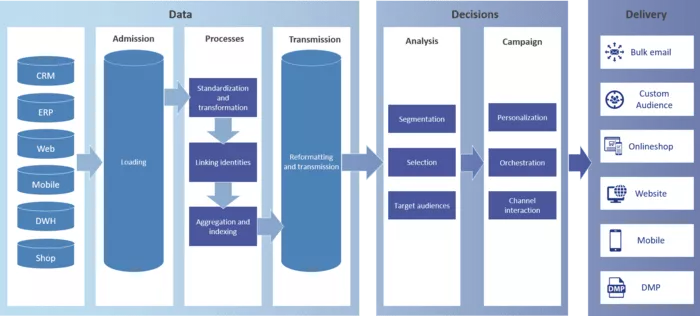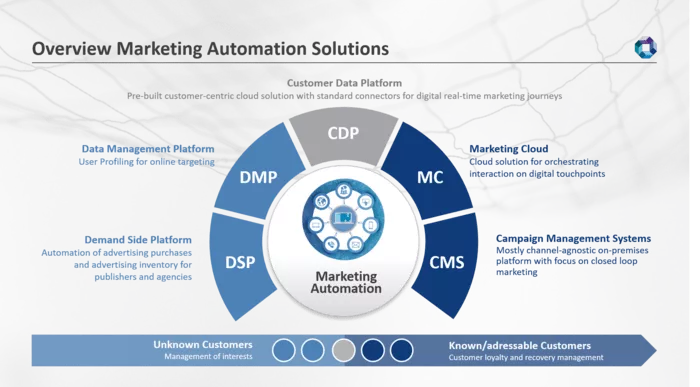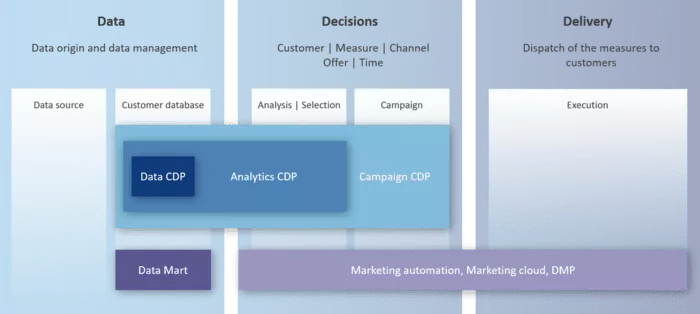German companies must venture a big step toward digital transformation and improvement of customer experience - this insight is evolving increasingly among decision-makers. The reasons for this are manifold:
- The number of customer touch points is growing, and background data needs to be used correctly here.
- Customers' expectations are rising immensely.
- New technologies have entered the world of marketers.
- Common campaign management systems are very expensive to implement.
- As the tool landscape continues to grow, it is important to retain a overview.
CDP systems, existent in the USA since 2013, appear to be right on cue here. Whereas campaign management systems tending to be based on workflow often automate CRM-based campaign processes in relational data models, CDP systems allow comprehensive treatment ranging from customer-centric data management in big-data technologies to e-mail dispatch in real time, in order to optimize the customer interaction across all digital channels such as the web, e-mail, mobile communications, online shops and social networks.
The three characteristics of a customer data platform:
- Out-of-the-box software: Quickly operable, low implementation costs, high level of maturity.
- Persistence: Customer-centric database allowing full, 360-degree customer views and integration of all data sources.
- Availability: Other systems can access CDP data without problems.
A use of big-data technologies makes customer data platforms very flexible and extremely fast in terms of data models, allowing every marketer able to apply, utilize and develop their CDP - regardless of BI / IT resources.
Data, decisions and delivery - the 3 phases of CDP architecture
The three phases comprising data, decisions and delivery represent data and process flows within a CDP:
In the first phase consisting of data acquisition, data from various data sources are loaded into the CDP. Before customers' identities can be created and linked, however, they need to be standardized and transformed. Customer-centric compression of data subsequently permits creation of further data logic. After transfer to the decision phase, the necessary analyses and selections can be performed in order to determine target groups and thereby subsequently define workflow-based campaign steps. Channels are then integrated in the final phase consisting of delivery.
Are CDP an campaign management solutions comparable?
An overview of functions:
The essential differences with respect to campaign management systems lie, firstly, in the area of data where customer-centric views can be set up independently, and secondly, in the real-time function domain, which strongly resembles a DMP. Furthermore, customer data platforms often do not possess the functional diversity as known to users from the world of campaign management.
The list below provides a rough overview of a CDP's functions:
- General functions: Maintenance of raw data, persistence of data, creation of 360-degree views
- Flexible data loading
- Support for identity management
- Wide-ranging data accessibility
- Personalization of websites
- Integration of mobile apps
- Use for digital marketing
- Use for offline marketing
- Conduction of analytics
- Modern channel interaction
When do I need what? A path through the maze of CRM terminology
A growing number of new buzzwords such as CRM, CMS, CDP, DWH, Data Mart, DMP, CMP & Co. is making the world of CRM increasingly complicated. An overview needs to be retained here: Which solution do I need for which usage in which customer lifecycle phase?
A rough overview of the different solutions in the marketing automation environment is provided by the following diagram (from the customer lifecycle point of view):
A different perspective of the three phases of CDP architecture (data, decisions, delivery) helps identify the respective extents of coverage:
- Data mart: It reproduces a customer-centric view in a part of the classic DWH in the customer intelligence environment. It compiles personal data on the marketing side, compresses these and makes them available to further systems for reporting, campaign management etc.
- Customer data platform (CDP): It merges the disciplines comprising customer database, analysis/selection and campaign management. Through standard connectors and identity matching, it creates the customer perspective necessary for campaigns , produces segments and selects target groups. These target groups then receive individually tailored offers. A channel to place customized content must be linked, however.
- Campaign management systems (CMS): These aim for a CRM-closed-loop approach, i.e. everything ranging from planning, analysis and execution to measurement is contained in one workflow-based solution. However, customer-centric creation of marketing data is required in advance; suitable for this purpose is regular loading from an upstream customer-centric data mart at a data warehouse.
- DMP: It collects and uses cookies as well as third-party data in order to recognize audiences in online marketing, address them online in real-time, and evaluate the related performance - also in real time.
CDP vs. campaign management system - when is introduction worthwhile?
At first glance, customer data platforms appear to be a modern, dynamic, streamlined and fresher version of a "classic" campaign management system. However, an enterprise always needs to ask the following question before deciding on a solution: Can a CDP also cover all our needs and wishes just like our current or planned campaign management solution? The following comparisons can facilitate the decision-making process:
- Customer-centric approach in a data mart/DWH vs. customer centric approach in CDP: How good are data modelling functions in CDP? As a marketer, can I independently establish a customer-centric point view and linkage of identities from all source systems? How do I intelligently link rudimentary customer data with other customer data even in the absence of a unique ID? What are the CDP solution's minimum requirements as regards necessary data? Do I only have structured data, or would I also like to use unstructured data? Or do I perhaps need an upstream customer-centric data mart after all?
- Big data vs. relational database: Big-data database technologies such as In-Memory and NoSQL are very suitable for use with CDP. Data modelling and data loading require little effort, depending on the data model, thus drastically shortening query and selection times. However, can the technology used in CDP also cover my planned, possibly very complex data model? Do I have an overview of all systems, tables, data and fields which I would like to transfer? If other (possibly proprietary) source systems are added to my data-warehouse source, I need to consider a detailed connection plan in advance. Depending on the business model, the issue of which data should be used to model customer behaviour, in particular, is usually not trivial and requires good planning.
- Features of CDP vs. campaign system: Most campaign management systems possess wide-ranging functions dedicated, inter alia, to control groups, contact strategies, campaign prioritization and optimization, as well as response definition and measurement. Because many of these functions are (usually) not available in a CDP, one has to determine whether these functions are necessary or dispensable for one's own campaign management.
Summary
When use of a particular solution makes sense and when it pays to switch to the other solution is determined by the answers to the questions above, and depends on the wishes, needs and goals of the respective organization. The catalogue of requirements, future architecture and associated use cases should therefore be compared individually with the considered campaign-management or customer-data-platform solution, in order to ensure a future-proof decision.
An overview of the providers of various CDP solutions, as well as tips & tricks for tool evaluations await you in the next blog posts!










